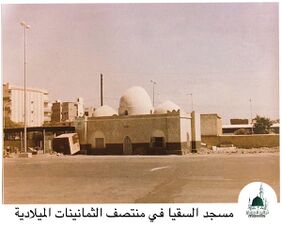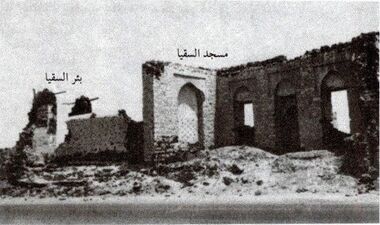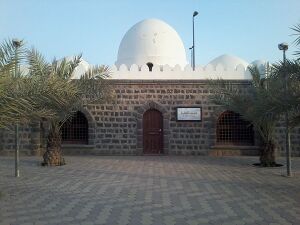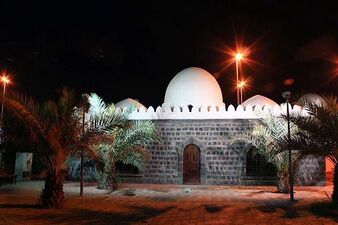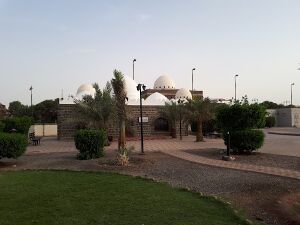Al-Suqya Mosque: Difference between revisions
m Engineer moved page Suqya Mosque to Al-Suqya Mosque |
No edit summary |
||
| Line 1: | Line 1: | ||
{{Building | {{Building | ||
| title = Suqya Mosque | | title = Al-Suqya Mosque | ||
| image = مسجد سقیا.jpeg | | image = مسجد سقیا.jpeg | ||
| image size = 350px | | image size = 350px | ||
| image link = | | image link = | ||
| image description = | | image description = | ||
| other names = Al- | | other names = Al-Ru'us Mosque | ||
| place = [[Medina]], | | place = [[Medina]], inside the area of al-'Anbariyya train station | ||
| usage = Mosque | | usage = Mosque | ||
| religious affiliation = | | religious affiliation = | ||
| Line 16: | Line 16: | ||
| time of construction = | | time of construction = | ||
| founder = | | founder = | ||
| events = | | events = Prayer of the [[Prophet Muhammad(a)]] when he was going to [[Badr]] | ||
| reconstructions = | | reconstructions = | ||
| time of reconstruction = 2001-2003 | | time of reconstruction = 2001-2003 | ||
| Line 53: | Line 53: | ||
| map description = | | map description = | ||
}} | }} | ||
''' | '''Al-Suqya Mosque'''(Arabic: {{ia|مسجد السقیا}}) is one of the mosques in [[Medina]], which is located in the southeast part of Medina railway station, in al-'Anbariyya neighborhood. This mosque is called al-Suqya; because it is located in the al-Suqya region near al-Suqya well. On the way to [[Battle of Badr]], the Prophet saw his army in Suqya, did his prayer, prayed for the people of [[Medina]], and drank water from the well of al-Suqya. | ||
==Location== | ==Location== | ||
Al-Suqya Mosque is located inside the fence of al-'Anbariyya railway station and in its southeast. The well of al-Suqya is located in the south of that mosque, and Tariq Makka Street separates the two (the well and the mosque).<ref>Anṣari, ''athar al-madina al-munawwara'', p. 136.</ref> Currently, al-Suqya Mosque is inside the railway station.<ref>Ja'fariyan, ''athar-i islami-yi Makka wa Madina'', p. 367.</ref> | |||
== | ==Name== | ||
This mosque is called | This mosque is called al-Suqya; because it is located in the al-Suqya region and near al-Suqya well.<ref>Abdu-l Ghani, ''Al-Masajid al-Athariyya fi al- madina al-munawwara'', p. 102.</ref> | ||
=== | ===Qubbat al-Ru'us=== | ||
From the 11th/ | From the 11th/16th century onwards, this mosque was also known as the Qubbat al-Ru'us.<ref>Anṣari, ''athar al-madina al-munawwara'', p. 136.</ref> According to 'Ali Hafiz, it was called Qubbat al-Ru'us because Ottoman Turks used to cut off the heads of desert bandits and put them there.<ref>Anṣari, ''athar al-madina al-munawwara'', P. 136; Numiri, ''Tarikh al-madina al-munawwara'', p. 146.</ref> Al-'Ayyashi, the historian of [[Medina]], believes that this name has a bad effect and is not worthy of this mosque.<ref>'Ayyashi, ''Al-Madina al-munawwara bayn al-maḍi wa al-haḍir'', p. 192.</ref> | ||
==Prophet(a) in | ==The Prophet(a) in al-Suqya== | ||
On the way from Medina to | On the way from Medina to the [[Battle of Badr]], the [[Prophet Muhammad(a)]] stopped in al-Suqya and did prayer and prayed: just as God blessed the people of [[Mecca]] after the prayer of the [[Prophet Abraham]](a), may He also bless the people of [[Medina]].<ref>Tirmidhi, ''Al-Jami' al-ṣahih'', vol. 5, p. 528.</ref> It is said that the Prophet saw his army in this place.<ref>Numiri, ''Tarikh al-madina al-munawwara'', vol 1., p. 72.</ref> It is reported that the Prophet(a) drank water from the al-Suqya well on his way to Badr.<ref>Ibn Sa'd, ''Al-Ṭabaqat al-kubra'', vol.1, p. 504.</ref> | ||
==History | ==History== | ||
Ibn | Ibn Shabba considers this mosque one of the mosques where the Prophet(a) has prayed.<ref>Numiri, ''Tarikh al-madina al-munawwara'', vol. 1, p. 72.</ref> According to al-Samhudi's report, [['Umar b. 'Abd al-'Aziz]] built this mosque at the place of the Prophet's prayer. According to the words of al-Samhudi, quoting Abu 'Abd Allah al-Asadi, one of the historians of the first centuries, this mosque was famous as one of the historical mosques of [[Medina]].<ref>Samhudi, ''Wafa' al-wafa'', vol. 3, p. 198.</ref> | ||
=== | ===Al-Samhudi's Report=== | ||
At the time of | At the time of al-Samhudi, this mosque was destroyed. He went to the place of the mosque and saw a big building stone, he ordered to dig there. After the exploration, the mihrab and the four corners of the al-Suqya Mosque appeared. Based on the decorations and carvings of the stones that were discovered, al-Samhoudi believed that this building was built during the time of [['Umar b. 'Abd al-'Aziz]].<ref>Samhudi, ''Wafa' al-wafa'', vol. 3, p. 200.</ref> According to al-Samhudi's report, al-Suqya Mosque in his time, was rebuilt on its original foundations, which is a square with an area of about seven cubits by seven cubits.<ref>Samhudi, ''Wafa' al-wafa'', vol. 3, p. 200.</ref> Ahmad al-'Abbasi's report in the 11th/17th century also confirms the area of this mosque.<ref>'Abbasi, '''Umdat al-akhbar'', p. 189.</ref> | ||
According to a report from | According to a report from 1073/1662-3 this mosque is located on the left side of the road leading to [[Medina]] from [['Aqiq]] route, in the western [[harra]].<ref>'Ayyashi, ''Al-Rihla al-'Ayyashiyya'', vol. 1, p. 395.</ref> | ||
=== | ===Yasin Khayari's opinion=== | ||
Scholars of the first and middle centuries are of the same opinion that the | Scholars of the first and middle centuries are of the same opinion that the Suqya Mosque is a historical mosque that is located inside the railway station today. Yasin Al-Khayari a contemporary historian of [[Medina]], said: the ruined building that was located next to the Suqya well in his time and was destroyed for the development of the road, is the Suqya Mosque.<ref>Khayari, ''Tarikh ma'alimal-madina al-munawwara qadiman wa hadithan'', p. 149.</ref>This dilapidated building is clearly visible in the picture he gave in his book. Muhammad 'Ilyas Abdu-l Ghani, with several reasons, has proved the famous opinion and rejected the opinion of Khayari.<ref>Abdu-l Ghani, ''Al-Masajid al-Athariyya fi al- madina al-munawwara'', p. 102-106.</ref> | ||
==Description of the mosque== | ==Description of the mosque== | ||
Shanqiṭi describes the Suqya Mosque as follows: Inside the buildings of the railway station, from the south, the Suqya Mosque can be seen, which has triple domes. The middle dome is bigger.<ref>Shanqiṭi, ''Al-Durr al-thamina fi ma'alim dar al-rasul'', p. 237.</ref> | |||
The mosque building has vertical and horizontal sections and consists of three empty spaces or gaps covered by three domes. The middle dome is the biggest of all the domes. Its | The mosque building has vertical and horizontal sections and consists of three empty spaces or gaps covered by three domes. The middle dome is the biggest of all the domes. Its mihrab is in the [[Qibla]] wall. In half of the north, east and west walls of its building, an arched and crescent-shaped valve with a circular arch is installed. The walls are plastered with white plaster.<ref>Ṣalihi Luma'i, ''Al-madina al-munawwara wa taṭawwuriha al-'umrani wa turathiha al-mi'mari'' P. 209-210.</ref> | ||
==Gallery== | ==Gallery== | ||
<gallery mode="packed" heights="150px"> | <gallery mode="packed" heights="150px"> | ||
file:مسجد سقیا قرن18.jpg|The old picture of | file:مسجد سقیا قرن18.jpg|The old picture of Suqya Mosque from the 80s. | ||
file:مسجد سقيا قرن 18 (2.jpg|The old picture of | file:مسجد سقيا قرن 18 (2.jpg|The old picture of Suqya Mosque from the 80s. | ||
file:مسجد سقيا 7.jpg|The picture of the destroyed building, attributed to the | file:مسجد سقيا 7.jpg|The picture of the destroyed building, attributed to the Suqya Mosque in the book Tarikh ma'alimal-madina al-munawwara, p. 149. | ||
file:مسجد سقيا 3.jpg|The picture of | file:مسجد سقيا 3.jpg|The picture of Suqya Mosque after Rebuilding. | ||
file:مسجد سقيا 4.jpg | file:مسجد سقيا 4.jpg | ||
file:مسجد سقيا 5.jpg|The picture of the | file:مسجد سقيا 5.jpg|The picture of the mihrab of Suqya Mosque. | ||
file:مسجد سقيا 6.jpg | file:مسجد سقيا 6.jpg | ||
</gallery> | </gallery> | ||
| Line 95: | Line 95: | ||
==References== | ==References== | ||
{{references}} | {{references}} | ||
* | *'Abbasi, Ahmad b. 'Abd al-hamid.'''Umdat al-akhbar''. Medina: al-Maktab al-'ilmiyya, [n.d]. | ||
* | *'Abdu-l Ghani, Muhammad 'Ilyas. ''Al-Masajid al-Athariyya fi al- madina al-munawwara''. Medina: [n.p], 2000. | ||
* | *Anṣari, 'Abdu-l quddus al-. ''athar madina al-munawwara''. Medina: Maktabat al-Salafiyya, 1973. | ||
* | *'Ayyashi, 'Abd Allah b. Muhammad. ''Al-Rihla al-'Ayyashiyya''. Abu Dhabi: Dar al-Suwaydi, 2006. | ||
* | *'Ayyashi, Ibrahim .''Al-Madina al-munawwara bayn al-maḍi wa al-haḍir''. Medina: al-Maktab al-'ilmiyya, 1972. | ||
* | *hafiẓ, 'Ali.''Fuṣul min tarikh al-madina al-munawwara''. Jeddah: Shirka al-madina al-munawwara, 1417 AH. | ||
*Ibn | *Ibn Sa'd, Muhammad b. Mani' al-hashimi al-Baṣri. ''Al-Ṭabaqat al-kubra''. Edited by Muhammad 'Abd al-Qadir 'Aṭa. Beirut: Dar al-Kutub al-'Ilmiyya,1410AH-1990. | ||
* | *Ja'fariyan, Rasul. ''athar-i islami-yi Makka wa Madina''. Tehran: Mash'ar, 1382 Sh. | ||
* | *Khayari, Sayyid Ahmad Yasin.''Tarikh ma'alimal-madina al-munawwara qadiman wa hadithan''. Riyadh: al-Amana al'amma li-lihtifal mi'at 'am 'ala t'sis al-mamlika al- 'arabiyya al-su'udiyya, 1419 AH/1999. | ||
* | *Numiri, Ibn Shabbah. ''Tarikh al-madina al-munawwara''. Edited by Fahim Muhammad Shaltut. Tehran: Mash'ar, 1380 sh. | ||
* | *Ṣalihi Luma'i, Muṣṭafa.''Al-madina al-munawwara taṭawwuriha al-'umrani wa turathiha al-mi'mari''. Beirut: Dar al-Nihḍa al-'Arabiyya, 1981. | ||
* | *Samhudi, 'Ali b. 'Abd Allah. ''Wafa' al-wafa bi akhbar dar al-Muṣṭafa''. Edited by Muhammad Muhyi al-Din 'Abd al-hamid. Beirut: 1984. | ||
* | *Shanqiṭi, Muhammad al-'Amin al-. ''Al-Durr al-thamina fi ma'alim dar al-rasul(s)''. Beirut: Mu'assisa 'Ulum al-Qur'an, 1411 AH. | ||
* | *Tirmidhi, Muhammad ibn 'isa al-. ''Al-Jami' al-ṣahih''. cairo: Dar al-hadith, 1419 AH. | ||
{{end}} | {{end}} | ||
[[fa:مسجد سقیا]] | [[fa:مسجد سقیا]] | ||
[[category: Historical places of Medina]] | [[category: Historical places of Medina]] | ||
[[category: Medina's Mosques]] | [[category: Medina's Mosques]] | ||
Revision as of 12:33, 17 December 2023
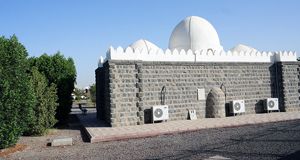 | |
| General Information | |
|---|---|
| Other Names | Al-Ru'us Mosque |
| Place | Medina, inside the area of al-'Anbariyya train station |
| Usage | Mosque |
| History | |
| Events | Prayer of the Prophet Muhammad(a) when he was going to Badr |
| Current State | |
| Status | Active |
Al-Suqya Mosque(Arabic: مسجد السقیا) is one of the mosques in Medina, which is located in the southeast part of Medina railway station, in al-'Anbariyya neighborhood. This mosque is called al-Suqya; because it is located in the al-Suqya region near al-Suqya well. On the way to Battle of Badr, the Prophet saw his army in Suqya, did his prayer, prayed for the people of Medina, and drank water from the well of al-Suqya.
Location
Al-Suqya Mosque is located inside the fence of al-'Anbariyya railway station and in its southeast. The well of al-Suqya is located in the south of that mosque, and Tariq Makka Street separates the two (the well and the mosque).[1] Currently, al-Suqya Mosque is inside the railway station.[2]
Name
This mosque is called al-Suqya; because it is located in the al-Suqya region and near al-Suqya well.[3]
Qubbat al-Ru'us
From the 11th/16th century onwards, this mosque was also known as the Qubbat al-Ru'us.[4] According to 'Ali Hafiz, it was called Qubbat al-Ru'us because Ottoman Turks used to cut off the heads of desert bandits and put them there.[5] Al-'Ayyashi, the historian of Medina, believes that this name has a bad effect and is not worthy of this mosque.[6]
The Prophet(a) in al-Suqya
On the way from Medina to the Battle of Badr, the Prophet Muhammad(a) stopped in al-Suqya and did prayer and prayed: just as God blessed the people of Mecca after the prayer of the Prophet Abraham(a), may He also bless the people of Medina.[7] It is said that the Prophet saw his army in this place.[8] It is reported that the Prophet(a) drank water from the al-Suqya well on his way to Badr.[9]
History
Ibn Shabba considers this mosque one of the mosques where the Prophet(a) has prayed.[10] According to al-Samhudi's report, 'Umar b. 'Abd al-'Aziz built this mosque at the place of the Prophet's prayer. According to the words of al-Samhudi, quoting Abu 'Abd Allah al-Asadi, one of the historians of the first centuries, this mosque was famous as one of the historical mosques of Medina.[11]
Al-Samhudi's Report
At the time of al-Samhudi, this mosque was destroyed. He went to the place of the mosque and saw a big building stone, he ordered to dig there. After the exploration, the mihrab and the four corners of the al-Suqya Mosque appeared. Based on the decorations and carvings of the stones that were discovered, al-Samhoudi believed that this building was built during the time of 'Umar b. 'Abd al-'Aziz.[12] According to al-Samhudi's report, al-Suqya Mosque in his time, was rebuilt on its original foundations, which is a square with an area of about seven cubits by seven cubits.[13] Ahmad al-'Abbasi's report in the 11th/17th century also confirms the area of this mosque.[14] According to a report from 1073/1662-3 this mosque is located on the left side of the road leading to Medina from 'Aqiq route, in the western harra.[15]
Yasin Khayari's opinion
Scholars of the first and middle centuries are of the same opinion that the Suqya Mosque is a historical mosque that is located inside the railway station today. Yasin Al-Khayari a contemporary historian of Medina, said: the ruined building that was located next to the Suqya well in his time and was destroyed for the development of the road, is the Suqya Mosque.[16]This dilapidated building is clearly visible in the picture he gave in his book. Muhammad 'Ilyas Abdu-l Ghani, with several reasons, has proved the famous opinion and rejected the opinion of Khayari.[17]
Description of the mosque
Shanqiṭi describes the Suqya Mosque as follows: Inside the buildings of the railway station, from the south, the Suqya Mosque can be seen, which has triple domes. The middle dome is bigger.[18] The mosque building has vertical and horizontal sections and consists of three empty spaces or gaps covered by three domes. The middle dome is the biggest of all the domes. Its mihrab is in the Qibla wall. In half of the north, east and west walls of its building, an arched and crescent-shaped valve with a circular arch is installed. The walls are plastered with white plaster.[19]
Gallery
-
The old picture of Suqya Mosque from the 80s.
-
The old picture of Suqya Mosque from the 80s.
-
The picture of the destroyed building, attributed to the Suqya Mosque in the book Tarikh ma'alimal-madina al-munawwara, p. 149.
-
The picture of Suqya Mosque after Rebuilding.
-
The picture of the mihrab of Suqya Mosque.
Notes
- ↑ Anṣari, athar al-madina al-munawwara, p. 136.
- ↑ Ja'fariyan, athar-i islami-yi Makka wa Madina, p. 367.
- ↑ Abdu-l Ghani, Al-Masajid al-Athariyya fi al- madina al-munawwara, p. 102.
- ↑ Anṣari, athar al-madina al-munawwara, p. 136.
- ↑ Anṣari, athar al-madina al-munawwara, P. 136; Numiri, Tarikh al-madina al-munawwara, p. 146.
- ↑ 'Ayyashi, Al-Madina al-munawwara bayn al-maḍi wa al-haḍir, p. 192.
- ↑ Tirmidhi, Al-Jami' al-ṣahih, vol. 5, p. 528.
- ↑ Numiri, Tarikh al-madina al-munawwara, vol 1., p. 72.
- ↑ Ibn Sa'd, Al-Ṭabaqat al-kubra, vol.1, p. 504.
- ↑ Numiri, Tarikh al-madina al-munawwara, vol. 1, p. 72.
- ↑ Samhudi, Wafa' al-wafa, vol. 3, p. 198.
- ↑ Samhudi, Wafa' al-wafa, vol. 3, p. 200.
- ↑ Samhudi, Wafa' al-wafa, vol. 3, p. 200.
- ↑ 'Abbasi, 'Umdat al-akhbar, p. 189.
- ↑ 'Ayyashi, Al-Rihla al-'Ayyashiyya, vol. 1, p. 395.
- ↑ Khayari, Tarikh ma'alimal-madina al-munawwara qadiman wa hadithan, p. 149.
- ↑ Abdu-l Ghani, Al-Masajid al-Athariyya fi al- madina al-munawwara, p. 102-106.
- ↑ Shanqiṭi, Al-Durr al-thamina fi ma'alim dar al-rasul, p. 237.
- ↑ Ṣalihi Luma'i, Al-madina al-munawwara wa taṭawwuriha al-'umrani wa turathiha al-mi'mari P. 209-210.
References
- 'Abbasi, Ahmad b. 'Abd al-hamid.'Umdat al-akhbar. Medina: al-Maktab al-'ilmiyya, [n.d].
- 'Abdu-l Ghani, Muhammad 'Ilyas. Al-Masajid al-Athariyya fi al- madina al-munawwara. Medina: [n.p], 2000.
- Anṣari, 'Abdu-l quddus al-. athar madina al-munawwara. Medina: Maktabat al-Salafiyya, 1973.
- 'Ayyashi, 'Abd Allah b. Muhammad. Al-Rihla al-'Ayyashiyya. Abu Dhabi: Dar al-Suwaydi, 2006.
- 'Ayyashi, Ibrahim .Al-Madina al-munawwara bayn al-maḍi wa al-haḍir. Medina: al-Maktab al-'ilmiyya, 1972.
- hafiẓ, 'Ali.Fuṣul min tarikh al-madina al-munawwara. Jeddah: Shirka al-madina al-munawwara, 1417 AH.
- Ibn Sa'd, Muhammad b. Mani' al-hashimi al-Baṣri. Al-Ṭabaqat al-kubra. Edited by Muhammad 'Abd al-Qadir 'Aṭa. Beirut: Dar al-Kutub al-'Ilmiyya,1410AH-1990.
- Ja'fariyan, Rasul. athar-i islami-yi Makka wa Madina. Tehran: Mash'ar, 1382 Sh.
- Khayari, Sayyid Ahmad Yasin.Tarikh ma'alimal-madina al-munawwara qadiman wa hadithan. Riyadh: al-Amana al'amma li-lihtifal mi'at 'am 'ala t'sis al-mamlika al- 'arabiyya al-su'udiyya, 1419 AH/1999.
- Numiri, Ibn Shabbah. Tarikh al-madina al-munawwara. Edited by Fahim Muhammad Shaltut. Tehran: Mash'ar, 1380 sh.
- Ṣalihi Luma'i, Muṣṭafa.Al-madina al-munawwara taṭawwuriha al-'umrani wa turathiha al-mi'mari. Beirut: Dar al-Nihḍa al-'Arabiyya, 1981.
- Samhudi, 'Ali b. 'Abd Allah. Wafa' al-wafa bi akhbar dar al-Muṣṭafa. Edited by Muhammad Muhyi al-Din 'Abd al-hamid. Beirut: 1984.
- Shanqiṭi, Muhammad al-'Amin al-. Al-Durr al-thamina fi ma'alim dar al-rasul(s). Beirut: Mu'assisa 'Ulum al-Qur'an, 1411 AH.
- Tirmidhi, Muhammad ibn 'isa al-. Al-Jami' al-ṣahih. cairo: Dar al-hadith, 1419 AH.

